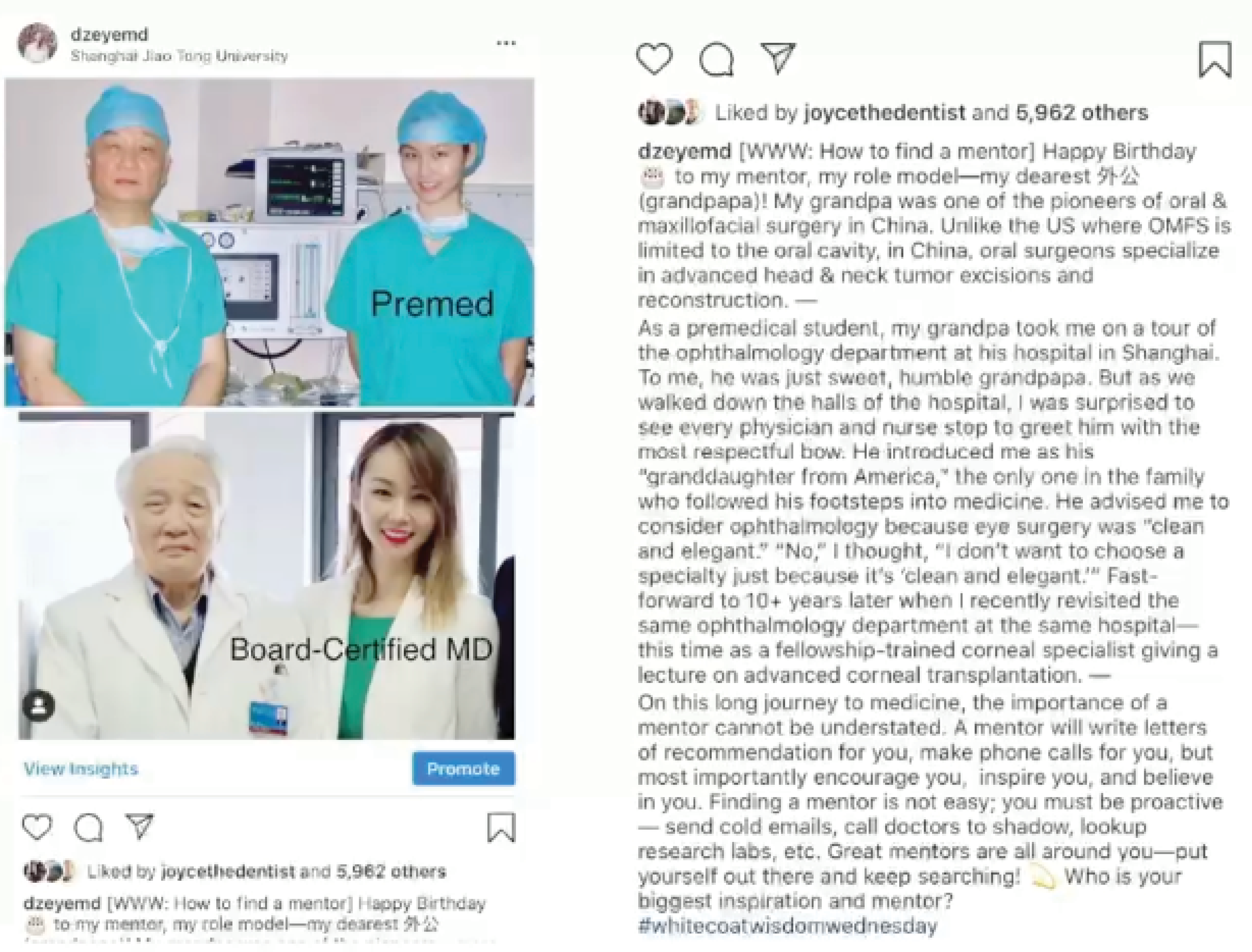Approximately 75% of patients search for health information online. This means that most are no longer asking their neighbors or friends for eye doctor recommendations; instead, they are consulting millions of strangers on the internet. Seeing as this trend will only continue to grow, ophthalmologists must meet patients where they are, and today that’s online—primarily on YouTube, Facebook, Instagram, and most recently TikTok.1 This article features 10 hacks to help ophthalmologists elevate their social media game.
1. Know Your Institution’s Social Media Policy
Before doing anything on social media, review your institution’s social media policy. These guidelines can range from requiring you to add a disclaimer indicating that the views expressed on your account are your own, to requiring that you not share photos or videos of you in their facility. Whatever the policy, be sure to follow it to a T. Trainees have been expelled from programs and health care workers have been fired for nonadherence. Also, everything you post on social media will remain online forever, so make sure you are comfortable with your content being seen by your patients, residency program director, and even future employer.
2. Be Consistent With Your Brand
Claim your social media handle now and use that handle across platforms. Even if you don’t expect to use a certain platform anytime soon, make an account and claim your handle, because you never know when it will come in handy. You should also decide whether you want to feature your practice (if you’re an owner) or yourself. Some people do both, but, in general, the doctor will perform better than the practice. The group I work for does a great job on social media, but patients relate more to individuals than to a faceless organization. Whichever approach you employ, make your content as personal as possible.
3. Tailor Content to Each Platform
A variety of social media platforms exist today, and it is important to know the audience for each. I find that the best tools for reaching patients are TikTok, Instagram, and YouTube, and the best for networking with industry are Twitter and LinkedIn. Essentially all platforms adequately enable interactions with colleagues. The platforms also have varying levels of formality, with TikTok being the most informal and LinkedIn being the most formal. You should tailor your content to each platform.
4. Find Your Niche
With so many doctors on social media, how can you stand out? When I first created my Instagram account, I shared a lot about my journey and therefore targeted pre-meds, medical students, and residents. The Figure shows a post I shared about my grandfather, who was a pioneer of oral surgery in China. To this day, it remains one of my most popular posts because it was relatable to my followers. This post alone reached more than 100,000 people and got me almost 500 new followers. That is a big ROI without spending any marketing dollars. (On Instagram, if you have a business account, you can look at insights to see how many users you reach with each post.)

Figure. One way to elevate your social media game is to find your niche.
But, maybe you don’t want to focus on mentorship. Maybe your niche is humor, like Dr. Glaucomflecken (Twitter @DGlaucomflecken), or education about cataract surgery, like Uday Devgan, MD, with Cataract Coach (Twitter @devgan). On YouTube, Shannon Wong, MD, produces patient-directed educational videos on cataract surgery, some of which have more than 1 million views. David Felsted, DO, does a great job sharing about his family (Instagram @felmology), and Shani Esparaz, MD (@shani_esparazmd), posts excellent content about motherhood. You can tailor your niche however you’d like, but sharing your life outside of the white coat shows your followers that you are more than just a doctor.
5. Post Regularly
Whichever platforms you decide to use, be sure to post regularly. I recommend posting every other day or at least once a week. But, of course, be realistic: We are doctors with busy jobs. Even a single post once in a while is better than nothing. If needed, you can always outsource this work or even hire someone to manage your social media.
6. Share Your Life Outside the White Coat (but Set Boundaries)
I recently copublished the largest and most comprehensive review of ophthalmic content on social media, specifically Instagram.2 My coinvestigators and I found that posts related to the doctor, especially those showcasing the doctor in a white-coat selfie, performed best. The least engaging posts were those that were purely educational, such as a picture of a slit-lamp photo. Clearly, your followers want to see you as a person, so be as personable as possible on social media. Share your life outside of medicine, to whatever extent you’re comfortable. For example, I am open on social media about being raised by a single mom and growing up in an immigrant family because this is a part of my identity.
7. Educate Through Patient Stories
Just because educational content may not perform as well as personal content doesn’t mean that education is not important on social media. It means that we must make the educational content more personal. I find that, when talking about a disease, it is helpful to tie in patient stories that resonate with followers on an emotional or visceral level. You can also make education fun. TikTok is great for making humorous doctor reaction videos, and they go viral easily. I posted a YouTube video of myself reacting to a notorious scene in “Final Destination” that shows so-called LASIK. The scene is filled with misinformation, which I combat by responding in an educational way.
8. Do Not Give Medical Advice
There is a clear distinction between educating about medicine and giving specific medical advice. I often receive messages from patients asking me to look at their case and share my opinion. I tell them that I cannot give medical advice online and invite them to come see me in clinic or reach out to their own health care provider.
9. Respect Patient Privacy
As ophthalmologists, we make a huge difference in people’s lives. I find the most effective way to reach patients is to share preoperative and postoperative transformation photos. With these posts, it is important to respect patient privacy and avoid violating HIPAA. I include a disclaimer that reads: Posted with patient consent. I also ask all surgery patients to sign a HIPAA-compliant media consent form (and almost all of them do so voluntarily). This enables me to create rich content on patients’ experiences that I can share through Instagram stories or other social media channels.
I recently received a message from a patient that read, “Hi, Dr. Zhu. I had LASIK 2 days ago. Doing great so far. Just wanted to say your Instagram stories are awesome and one of the reasons why I picked your practice over three other places in SoCal. I did 6 weeks of intense LASIK research, four total consultations, and even contemplated flying to Minnesota for LASIK. Long story short, I’m super happy.” This testimonial shows the power of social media and its ability to inform patients in their process of choosing an eye surgeon.
10. Amplify Your Reach
To take your marketing to the next level, you must amplify your reach on social media. A great way to do this is by collaborating with influencers. Tyler Oakley was one of the OGs of YouTube and now has 5.8 million followers on Instagram. I performed his LASIK, and, in return, he shared his experience on social media and created a LASIK Q&A video. That video has garnered more than 100,000 views, which equates to 100,000 potential patients—all for zero marketing dollars. All I did was ask him to sign a barter contract/exchange agreement: I provide free LASIK, and he provides social media content. Is it worth it? If even five patients sign up for LASIK as a result, the ROI is significant.
CONCLUSION
Social media is here to stay. I encourage those who are still on the sidelines to jump on in and those who are active to consider the ways in which you can elevate your game. These platforms can be powerful tools for ophthalmologists, but it is all what you make it.
1. Social media use in 2021. Pew Research Center. April 7, 2021. Accessed April 1, 2022.
www.pewresearch.org/internet/2021/04/07/social-media-use-in-2021/
2. Huang AS, Abdullah AAN, Chen K, Zhu D. Ophthalmology and social media: an in-depth investigation of ophthalmologic content on Instagram. Clin Ophthalmol. 2022;16:685-694.



